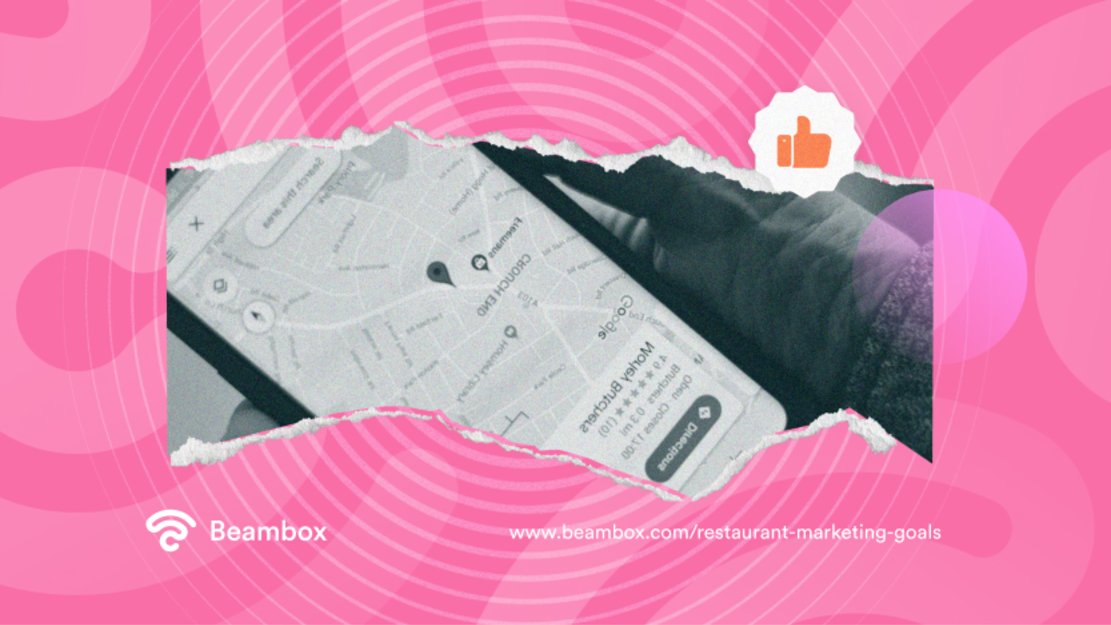Restaurant owners typically set aside a fixed budget annually or quarterly just to spend on marketing. But how do you know whether the investment was even worth it or not? Setting restaurant marketing goals helps you judge that.
If you’re on a journey without a destination in mind, how will you know if it was successful? Running a restaurant business is no different.
Here, setting goals gives you a helping hand to market effectively and fill your venue with happy customers.
However, your marketing goals must align with your business goals. Otherwise, you’ll have a crowd of customers you don’t know what to do with! So, let this article guide you through the process of setting marketing goals correctly with four examples for better understanding.

Is Defining Goals and Setting Objectives the Same Thing?
It’s a common practice to mistake goals and objectives as one and the same. While it may not sound like a big deal on the outlook, it can interfere with your business’s success. Here’s how.
If you think goals and objectives are the same, you’ll probably only set one or the other. But the truth is, you need both to make your business thrive.
Let’s see the difference between goals and objectives to help you understand this better.
A goal is a broad aim you have in mind, while objectives are the small milestones to achieve that goal. In other words, you won’t know how to reach your goal without setting small, achievable objectives.
Alternatively, if you only set short-term objectives without a long-term goal, you’ll never reach where you want to. Fulfilling the immediate aims will likely keep you satisfied with your performance when, in reality, it’s not enough. This false sense of achievement will hang your business by a thread.
However, a discussion about differences is never complete without an example.
Suppose you want to achieve a 20% increase your total revenue in one year. This is a goal because it spans over a long period.
Now, what are the different ways you can increase your revenue? You can try acquiring new customers, increasing prices strategically, getting more repeat customers, etc.
Whatever route you take, you’ll have to put in some effort. For example, to get more repeat customers, you’ll have to initiate restaurant loyalty programs, send out personalized marketing campaigns, etc. These will be your objectives since they’ll work towards achieving your main goal of increasing revenue.
How To Set Restaurant Marketing Goals According to Your Business Goals?
Businesses spend anywhere from 6 to 14% of their revenue on marketing. Moreover, marketing doesn’t only cost money; it takes time and effort as well.
Now, why would you put in your money and effort if there wasn’t something to achieve in return? If you’re marketing your restaurant, it means you want to take it to a specific level.
That level will be your business goal. Now, if you think of restaurant marketing ideas without this business goal in mind, would it be successful? No. You might get some benefit out of it, but you won’t reach that specific level.
Therefore, setting restaurant marketing goals that align with your business goals is the heart of the matter. Here’s how to do that.

Step 1: Set Your Business Goals
The first step is to set a business goal. As mentioned in the example earlier, it can be to increase revenue. Or you might want to increase online sales, improve your menu, maximize sustainability, etc.
However, this goal shouldn’t be vague. Saying, “Our goal is to increase the revenue,” won’t get you anywhere. How much increase do you want and in how much time? Answering these questions will be a step in the right direction.
There’s even a term for it. Your restaurant goals should be SMART, which stands for Specific, Measurable, Achievable, Sustainable, and Timely.
Now, to set your goals according to this acronym, here’s what you need to do:
- Specific: The addition of time makes the goal more specific. A good example would be, “We want to increase our monthly revenue.”
- Measurable: Now add a number so you can later judge whether or not you achieved the goal. Say, “We want to increase our monthly revenue by 10%.”
- Achievable: Your business goal must also be achievable. If you aim for a 50% increase monthly, you’re setting yourself up for failure. But a 10% increase is realistically achievable.
- Relevant: Your goal still isn’t good if it doesn’t align with your needs at that time. Maybe you’re at a stage where you need to focus more on sustainability. So, make sure the goal is relevant to your needs.
- Timely: Not giving yourself a deadline is yet another mistake that can have the opposite effect. How early you want to achieve your goal is another question you must answer. Let’s say you give yourself three months.
So your SMART goal would be “We want to increase our monthly revenue by 10% in three months.”
Step 2: Analyze Your Audience
Anyone who interacts with your restaurant, directly or indirectly, won’t be at the same customer journey stage. Using the same strategy for each group will be a recipe for disaster. So, the next step is to analyze your audience and compile realistic customer profiles.
You can do this by visiting competitors, collecting customer data, conducting surveys, etc.
When you go through this process, you will come across four types of audiences. Let’s start with the one that will require the least work.
These people are fully aware of your restaurant and ready to dine at your place. Then what’s stopping them? Well, they may be waiting for a discount, unique menu items, or just a gentle push from your side.
The second category has people who are aware of your restaurant but need convincing. For this group, you might have to create campaigns that show the appetizing nature of your food.
Or if you have a unique selling point, like organic ingredients, pushing that forward will help.
Then, some people are unaware of your business. This time, your marketing efforts must be to promote your vision, unique selling points, menu, etc.
Giving them enticing pictures of your restaurant through social media marketing is a good start. Now, once they become aware, they may or may not show interest. If they show interest, place them in the above groups. And if they don’t, continue reading for the last category.
These people don’t like your restaurant and aren’t interested. Here, you’ll have to participate in aggressive campaigning. Try to find their issues and solve them. When they see you care about them and are making efforts, they’ll likely change their mind about your restaurant.
Step 3: Set Your Marketing Goals
Once you’ve analyzed your audience, you must have a percentage for each group. Now, it’s time to set your marketing goals using those numbers. Let’s say you have the following percentages in your audience:
- 30% of people are aware and ready.
- 40% of people are aware but need convincing.
- 20% of people are unaware.
- 10% of people are aware but don’t like your restaurant.
Suppose your calculation says that you can increase your revenue by 10% if the second category becomes 45%.
This will be your marketing goal: to get 5% more leads in the second category. Now, because you want to increase the revenue in three months, you must achieve your marketing goal before that.
So, here’s your SMART restaurant marketing goal: “We want to convert 5% more of the aware category in 2 months.”
To achieve this goal, come up with small, weekly objectives. For example, in the first week, roll out a social media campaign about your use of organic ingredients. Next week, take the audience inside your kitchen to prove this and show off your hygiene.
Make sure this content reaches the right category by doing targeted marketing campaigns.
By the third week, you’ll have convinced most of the people, and now they’ll be a part of the first category. So now, initiate a discount scheme like giving a dessert free with the main course. Or a 15% discount to people who make online reservations, etc.
But remember, this is just an example, and what you must do might be different depending on your specific audience.

Let’s Put It Into Action: 4 Examples of Marketing Goals for a Restaurant
Now that you know how to create marketing goals that align with business goals, let’s put them into action.
Remember that you can achieve one business goal with many marketing goals. Your choice depends on your preference and how easily you can achieve it. Your restaurant marketing strategy should reflect it.
But for that, you must know what type of marketing goals people normally set. This will help you shape your own. So here are four examples of marketing goals for a restaurant.
Example 1: Increasing Restaurant Awareness and Boosting Engagement
The main goal of using marketing channels is to bring your restaurant in front of as many eyes as you can.
After all, customers won’t be able to dine in your restaurant if they don’t know about it. Think of it this way: What brand comes to your mind when you think of fried chicken or soft drinks? You probably thought of KFC for the first one and Coca-Cola for the second.
That’s the real definition of brand awareness. The same is true for your business. Your restaurant must be the first to pop up when people think of the dining you offer.
But how would this be possible? By identifying that one trait about your restaurant that is unique and resonates with your audience.
Take McDonalds for example. Its fries are one of a kind, and it’s hard to get the same taste elsewhere. On the other hand, Starbucks’ ambiance, friendly service, and loyalty programs have won the hearts of the masses.
Take a page out of the book of these brands and pinpoint something like this. If you own a coffee shop, have a quiet reading corner with books people can borrow or buy.
Whereas for the premium side, learn the steps of service in fine dining and provide your customers with a luxurious experience. Sometimes, fine-dining restaurants don’t follow the proper ritual. So, differentiating yourself by applying the right etiquette will be helpful.
Once you have the trait, promote it on social media platforms and inform people. But remember that your target customers should relate to your campaigns. They must think, “Yes, that’s exactly what I want.”
That’s where people will start engaging with your content, spreading it further to increase your popularity.
Example 2: Making Customers Stay Forever
You’ll never hear a business owner saying they don’t care about customer loyalty. In fact, that’s another marketing goal that restaurants strive for. Loyal customers later become the best brand ambassadors for free!
They praise your restaurant to friends, family, and social media, encouraging everyone to try you out. And the truth is, their word of mouth can sometimes outrun the benefit of thoughtful marketing campaigns. Here’s how to achieve this.
You must first pay attention to customer satisfaction. The best way of doing that is by giving exceptional service and maintaining your food quality.
When customers feel welcomed, listened to, and get value for money, they’ll never go to your competitors. They’ll leave good reviews on Google, social media, and anywhere your restaurant is present.
But what if someone leaves a bad review? Well, don’t panic. Try to get to the root of the problem and solve it as soon as possible. That’s another way to make a customer loyal.
Additionally, you can initiate loyalty programs in your restaurant. Offer discounts and make your customers feel like they’re a part of something special. Stats show that loyalty programs influence the buying decisions of over 83% of customers. So why not take advantage of that?
Create a point system and reward customers according to the points they gather. The more loyal customers will get the most rewards.
Or you can try referral programs where you give incentives to people who bring new customers for you. For example, create a referral link to your app. Then, give a 25% discount to whoever promotes your app through that link. But remember only to reward when you actually get a download.
And lastly, invest in personalized campaigns. For this, you’ll have to gather customer data on preferences, likes, and dislikes.

Example 3: Appearing Higher in Google’s Spotlight
Ranking higher in search results will continue this list of examples for restaurant marketing goals. What good would all your blog content be if your website hides on the last page of Google? Even being on the second page is not good enough with the rising competition!
Therefore, restaurants often aim to rank higher on Google, especially in local search results. That’s the most important spot for you since that’s where potential customers will look when trying to find you.
When people want to eat out, they usually search for “restaurants near me.” If you’re near a customer, you should appear in that search result, and that’s why local SEO is important. But the question is, how do we get there?
Start by searching for your restaurant on the Google Business Profile website. Once you find it, claim your listing and add your information. The main things would be your address, phone number, opening hours, etc.
It’s a good idea to add your menu pictures and description because people usually want to see what you offer.
However, online reviews are a key player for Google to decide which restaurants should appear. If you have more negative reviews than positive ones, Google isn’t likely to show you on local search results.
Therefore, managing your online reputation and getting Google reviews is the right path to choose. Of course, you can’t stop people from posting negative reviews or remove them.
But you can reply to those reviews and try to find out where the problem is. People always appreciate brands who listen to them and solve their issues. Plus, don’t stay away from investing in Google Ads.
Example 4: Getting Your Restaurant in Front of More Eyes
Lastly, let’s talk about getting your restaurant in front of more people with a strong online presence.
Acquiring new customers is hard. But with the right restaurant marketing solutions, you can increase your social media followers and website traffic.
However, these new eyeballs won’t instantly become customers. You’ll have to keep rolling out content to spread awareness and make them fond of your offerings. You’ll slowly and gradually find them waiting at your doorstep, ready to try your food! Here’s how to achieve this goal.
If you’re ready to take your marketing seriously and have set aside a budget, start by running paid ads. This is one of the most common ways to get more followers on social media.
Moreover, position yourself as the expert in your niche. Show off your chef’s skills and be transparent with your target audience. Putting out informative and engaging content with tasty pictures is the right first step!
Additionally, contact food influencers in your area to promote your restaurant in return for incentives. You can either give them special discounts or pay them for their promotion.
Whatever your payment method might be, you’ll get a chunk of their followers. Furthermore, personalized email marketing can also bring more people to your website.
But don’t just focus on gaining followers. Engage with them on social media to tell them you care. Looking at comments is the best way to know your audience. Furthermore, run contests and giveaways to excite people and get them to follow you.
Moving onto website traffic, post informative articles about the food you provide. You can occasionally include recipes and run recipe contests to engage your website visitors. Think of engaging headlines, apply search engine optimization strategies, and add pictures and internal links.
Optimize Your Marketing Goals To Get the Domino Effect for Your Business
Marketing goals are like a judge for your campaigns. They tell you whether or not your marketing was successful. If you don’t know what you want to achieve, how will you know when you’ve achieved it?
If you want to achieve your restaurant marketing goals with the help of WiFi marketing, try out Beambox. It will help you gather data about your customers, promote your brand, and automate your campaigns. Moreover, you can grow your online reputation on the main review platforms in no time.
Over 12,000 venues are using Beambox to scale their business. Do you want to be next? Start your free trial today!
Get Started With Free WiFi Marketing
Beambox helps businesses like yours grow with data capture, marketing automation and reputation management.
Sign up for 30 days free